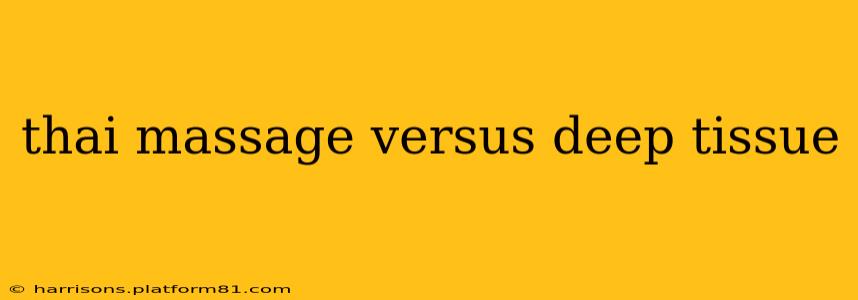Choosing between a Thai massage and a deep tissue massage can feel overwhelming. Both offer therapeutic benefits, but their techniques and effects differ significantly. This comprehensive guide will delve into the nuances of each, helping you determine which massage best suits your needs and preferences. We'll explore the key differences, benefits, and potential drawbacks to help you make an informed decision.
What is Thai Massage?
Thai massage, also known as Thai yoga massage, is an ancient healing art originating in Thailand. It's a unique blend of acupressure, assisted stretching, and gentle rocking. Unlike many other massage styles, Thai massage is performed on a mat on the floor, with the recipient typically wearing loose clothing. The therapist uses their hands, elbows, knees, and feet to apply pressure to specific energy lines (Sen lines) throughout the body. The focus is on improving energy flow, promoting flexibility, and relieving muscle tension.
Benefits of Thai Massage:
- Improved Flexibility and Range of Motion: The assisted stretches incorporated in Thai massage help increase flexibility and range of motion, making it beneficial for individuals with limited mobility or those recovering from injuries.
- Increased Energy Levels: By promoting energy flow, Thai massage can leave you feeling energized and revitalized.
- Stress Reduction: The rhythmic movements and gentle pressure can help reduce stress and promote relaxation.
- Improved Circulation: The acupressure points stimulated during the massage help improve blood circulation.
What is Deep Tissue Massage?
Deep tissue massage targets the deeper layers of muscle and fascia (the connective tissue surrounding muscles). It uses slow, deep strokes and sustained pressure to release chronic muscle tension and pain. This type of massage is often recommended for individuals experiencing persistent muscle pain, stiffness, or injury. Unlike Thai massage, deep tissue massage is generally performed on a massage table with the recipient undressed or wearing comfortable clothing.
Benefits of Deep Tissue Massage:
- Pain Relief: Deep tissue massage is highly effective in relieving chronic muscle pain and stiffness.
- Improved Posture: By releasing tension in tight muscles, it can improve posture and body alignment.
- Reduced Muscle Spasms: The deep pressure can help relax muscles and reduce spasms.
- Increased Range of Motion: Similar to Thai massage, deep tissue massage can improve flexibility and range of motion.
Thai Massage vs. Deep Tissue Massage: A Detailed Comparison
| Feature | Thai Massage | Deep Tissue Massage |
|---|---|---|
| Technique | Acupressure, assisted stretching, rocking | Deep, slow strokes, sustained pressure |
| Pressure | Varies, generally moderate to firm | Firm to deep pressure |
| Location | Mat on the floor | Massage table |
| Clothing | Loose clothing | Undressed or comfortable clothing |
| Focus | Energy flow, flexibility, relaxation | Muscle tension release, pain relief |
| Best for | Stress relief, flexibility improvement, gentle muscle tension | Chronic pain, muscle stiffness, injury recovery |
Which Massage Is Right for Me?
The best massage for you depends on your individual needs and preferences. Consider the following:
- Your Pain Level: If you have acute or severe pain, deep tissue massage may be more appropriate. For general stress relief and muscle tension, Thai massage could be a good starting point.
- Your Flexibility: If you have limited flexibility, Thai massage's focus on stretching could be beneficial.
- Your Preference for Pressure: If you prefer a gentler massage, Thai massage may be more suitable. Deep tissue massage requires a higher tolerance for pressure.
- Your Goal: What are you hoping to achieve from the massage? Stress reduction, pain relief, increased flexibility? Your goal will help guide your choice.
What are the potential downsides of each massage type?
Thai Massage: Some individuals may find certain stretches uncomfortable, especially if they have pre-existing injuries or conditions. The massage can be quite energetic and may not be suitable for individuals who prefer a completely relaxing experience.
Deep Tissue Massage: Deep tissue massage can cause some soreness or bruising, particularly after the first session. It's crucial to communicate your comfort level with your therapist throughout the session. It's also not recommended for individuals with certain medical conditions such as blood clots or osteoporosis.
Is there a specific type of pain one massage is better suited for than the other?
Deep tissue massage excels at addressing chronic muscle pain, stiffness, and pain stemming from injuries or repetitive strain. Thai massage is generally more suitable for relieving general muscle tension, improving flexibility, and promoting relaxation. However, a skilled therapist can adapt techniques to address various pain types within each style.
Ultimately, consulting with a qualified massage therapist is essential to determine the most appropriate massage type for your specific needs and health condition. They can assess your individual circumstances and recommend the best approach for optimal results.
